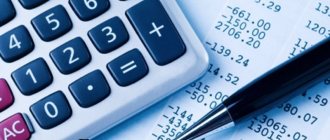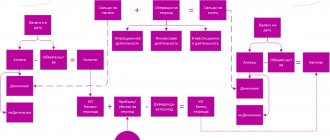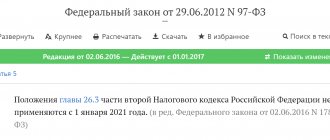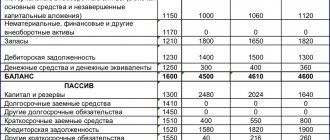How are balance sheet and income statement indicators related?
The financial reporting forms contain final indicators that characterize the financial results of the company as of the reporting date.
So, in the balance sheet it is line 1370 “Retained earnings (uncovered) loss”, and in the statement of financial results (Form No. 2) it is line 2400 “Net profit (loss)”, respectively. Despite the similarity, the rules for forming these values differ. Therefore, the amounts may not match. So, in line 1370 of the balance sheet you transfer the balance of account 84 “Retained earnings (uncovered loss)”, which is formed on an accrual basis from year to year since the beginning of the company’s activities. And the indicator on line 2400 of form N 2 must coincide with the amount of net profit (loss) for the reporting year. That is, in Form No. 2 you show the financial result of a particular year, it is equal to the final balance in account 99 “Profits and losses” for the year. It is this value that you then write off to account 84 when reforming the balance sheet.
To figure out whether in your particular case the amounts of profit (loss) in the balance sheet and form N 2 should coincide, let's look at how these values are formed.
Essence of the question. The indicator of line 1370 of the balance sheet and 2400 of form N 2 may not coincide. After all, the balance of account 84 is transferred to the balance sheet, which is formed by an accrual total for the entire existence of the organization. And in form N 2 only the financial result is shown - profit (loss) for the reporting year.
Component strings
As we have already found out, in the column with line 1370 the amount of uncovered loss or the amount of retained profit should be entered.
The period for which this amount accumulated and how much it amounted to during the reporting period is indicated:
Both the pros and cons are not listed on the same line. There is a separate account for each of them.- The report indicates not only the amounts accumulated from ordinary transactions, but also the amounts that are directly related to this group.
The amounts obtained by plus or minus are calculated using a special formula. To make the calculations, you need to calculate the net amount of profit or loss for a specific period. This includes those amounts that remained in the report after taxation. These amounts will be useful to fill out the line.
Situation No. 1. The amounts of profit (loss) in the balance sheet and form No. 2 are the same
So, in line 1370 of the balance sheet you show the sum of two values - the profit or loss that was at the beginning of the year, and the financial result for the year (account balance 99). While in form N 2 you show only the account balance 99.
When can the balance sheet and income statement be the same? This is possible if the profit that was reflected at the beginning of the year in account 84 was spent by the end of the year, that is, equal to zero. Then in both reporting forms you will show an account balance of 99.
Note! An accountant cannot decide for himself where to spend the company's profits. Such a decision must be made by the founders at the general meeting and documented in the form of minutes.
How can you spend profits from previous years, you ask? Only on the basis of the relevant decision of the founders. They can order to spend profits on the formation of reserve capital, payment of dividends, etc. In these cases, the corresponding amounts are written off from the credit of account 84. So, if the profit of previous years has been spent completely, the balance sheet and form N 2 indicators will coincide, since they will reflect only the profit of the current year.
Another option is that the indicators in lines 1370 of the balance sheet and 2400 of the report will be equal if at the beginning of the reporting year you had no profit (loss) from previous years on account 84.
Is it true that retained earnings are net profits?
Retained earnings are truly net profits that (as the name suggests) were not distributed (divided) among the participants/shareholders of the company.
Net profit is considered to be that part of income from sales and non-sales operations that remains after paying taxes. The decision on how to distribute this income rests solely with the owners. Traditionally, the issue of retained earnings is put on the agenda of the annual meeting of the company's owners. The adopted decision is documented in minutes, which are drawn up following the results of the general meeting of participants/shareholders.
For information on how such a document is drawn up, read the article “Decision on payment of dividends to an LLC - sample and order.”
The main ways of spending retained earnings are considered to be in the following directions:
- to pay dividends to participants/shareholders;
- repayment of past losses;
- replenishment (creation) of reserve capital;
- other goals formulated by the owners.
For information about the accounting entries accompanying the accrual, payment and receipt of dividends, read the material “Accounting entries for the payment of dividends”.
Turnover of Signal LLC for 2014 according to account 84
| Operation | Sum | Wiring |
| Accumulated profit of previous years as of January 1, 2014 | 25,000 rub. | Credit balance on account 84 at the beginning of the year |
| Dividends paid for 2013 | 10,000 rub. | Debit 84 Credit 75 |
| Interim dividends for 2014 were paid. | 5000 rub. | Debit 84 Credit 75 |
| The profit received at the end of 2014 was written off. | 30,000 rub. | Debit 99, sub-account “Profit of the current year”, Credit 84, sub-account “Retained earnings (uncovered loss)” |
The balance of account 84 as of December 31, 2014 is:
40,000 rub. .
In line 1370 of the balance sheet, the accountant recorded the amount of 40,000 rubles. And in line 2400 of form N 2 - 30,000 rubles. — the amount of the debit balance at the end of the year for account 99, subaccount “Profit (loss) of the current year.” It was this amount that on December 31, 2014, he transferred to the credit of account 84 when reforming the balance sheet.
Situation No. 2. The amounts of profit (loss) in accounting forms differ
In most cases, the final financial result of the balance sheet and the final financial result of Form N 2 will not coincide. For example, if your company made a loss last year, you will reduce the current year’s profit by that amount. Or increase the size of the current loss. Thus, here the account balance of 84 at the end of the year and the account turnover of 99 cannot possibly coincide. Let’s say that in 2013 the company had a loss of 10,000 rubles. (debit balance on account 84). And for 2014 the profit was 12,000 rubles. (balance on the debit of account 99, subaccount “Profit (loss) of the current year”). The final balance on account 84 credit for 2014 will be equal to 2000 rubles. (12,000 rubles - 10,000 rubles).
V.V. Zoreva
Expert of the magazine "Simplified"
What's happened?
The Federal Tax Service of Russia published a letter dated July 31, 2021 No. BA-4-1/ [email protected] , in which it informed all taxpayer organizations, as well as its territorial authorities:
- recommended machine-readable forms of financial statements, including simplified ones, which are subject to submission to the tax authorities for the reporting year 2021;
- control ratios necessary to verify the financial statements provided.
Amendments to the reporting forms and control ratios were made in connection with the adopted amendments to the Federal Law of December 6, 2011 No. 402-FZ “On Accounting”.
New balance sheet and other reporting forms
Starting from 2021, the Federal Tax Service of Russia is obliged to create and maintain a state information resource for accounting (financial) reporting. Therefore, organizations have been relieved of the obligation to submit a legal copy of their financial statements for 2021 and beyond to the statistical authorities. You only need to report to the Federal Tax Service at your place of registration. It was established that:
- small businesses submit reports on paper or in the form of an electronic document;
- all other economic entities submit reports in the form of an electronic document.
That is why the forms have been brought into compliance with the new requirements. The most changes were made to Form No. 2 “Report on Financial Results”, in particular, it changed:
- Name,
- line numbers,
- composition of the indicator “Income tax”.
Current forms of accounting (financial) statements are posted on the websites of the Federal Tax Service of Russia and JSC GNIVC. They should be applied starting with reporting for the current year.
Retained earnings: calculation formula
According to general accounting data, retained earnings are a company's net profit after taxes that can be distributed to the company's owners.
NPk = NPn PE – Div,
NPk - NP at the end of the reporting year;
NPn - NP at the beginning of the reporting period;
PE - net profit remaining after accrual of income tax;
Div - dividends paid in the reporting year based on the NP of previous years.
If you do not have the NP value, then to calculate the NP you can use the following scheme:
- first calculate profit before tax (to determine it, calculate operating profit, which is defined as the difference between operating income and operating expenses);
- then subtract depreciation and interest costs from operating profit;
- Subtract tax from the resulting profit value.
To find out whether it is possible to see the amount of operating profit in the accounting statements, read the article “Which line is operating profit reflected in the balance sheet?”
New control ratios for balance, form No. 2 and form No. 3
The control ratios in form No. 2 for the line “Net profit” have changed. Now the indicator “Net profit or loss” of the balance sheet on line 2400 of column 4, 5 should be equal to the sum of lines 2300 “Profit (loss) before tax”, 2410 “Income tax” and 2460 “Other” in columns 4, 5, respectively. If an indicator for a line is in parentheses, then a minus sign (-) is placed in front of it.
The indicator “Cumulative financial result of the period” reflected in line 2500 of columns 4, 5 should be equal to the sum of lines 2400 “Net profit (loss)”, 2510 “Result from the revaluation of non-current assets not included in the net profit (loss) of the period”, 2520 “Result from other operations not included in the net profit (loss) of the period” and 2530 “Profit tax from operations, the result of which is not included in the net profit (loss) of the period”, columns 4, 5, respectively. The rule for reflecting a negative indicator in parentheses also applies to it.
These and other control ratios in the letter of the Federal Tax Service are traditionally shown in the table. It indicates the names of the reporting forms, the control ratios themselves, the possible errors they indicate, and the actions of the inspectors when identifying a discrepancy. Practical recommendations are also given. In particular, it is indicated how to calculate the increase or decrease in capital for the previous year in the “Statement of Changes in Capital”. The rules for calculating cash flows from current operations in the “Cash Flow Report” and the amount of funds received in the “Report on the Purposeful Use of Funds” are also defined.
Question:
We prepare a balance sheet and Form 2 “Profit and Loss Statement” for the 1st half of 2021. Accountants tell us that the line “retained earnings” in the balance sheet should converge with the similar line 2400 in Form 2, but it diverges by 8 thousand. If you look at the balance sheet, then the balance of account 99.01.1 clearly appears in the balance sheet, but in form 2, line 2400 is calculated using formulas and collected from different accounts. And here the question arises: should these lines converge? And for any period, maybe they will coincide at the end of the year, when there will be reporting for the whole year and there will be a reformation of the balance sheet?
Our opinion:
The relationship between the indicators of the Balance Sheet and the Profit and Loss Statement is observed under the following conditions:
Please note that the indicators are interrelated (equal) if during the reporting period there was no turnover on account 84 (with the exception of balance sheet reformation). For example, no dividends were accrued and no contributions were made to reserve capital. If the balance of retained earnings was used in the reporting period, then the amount of profit used should be a discrepancy between lines 1370 of the Balance Sheet and 2400 of the Income Statement.
The procedure for filling out the Balance Sheet and the Profit and Loss Statement when preparing interim reporting has the following features:
The procedure for filling out the Balance Sheet and the Profit and Loss Statement when preparing annual reports:
Indicators for investors
When analyzing the financial condition of a company, investors pay attention to the use of retained earnings. If NP accumulates and is not put into circulation, this state of affairs should seem to suit investors, since they can count on significant dividends.
However, without investment in its activities, the company stops growing, and its income not only does not increase, but may also decrease (due to a drop in competitiveness, high wear and tear of equipment, and for other reasons related to the lack of investment). So a company that accumulates profits but does not invest in its activities cannot be attractive.
At the same time, a company that does not make a profit and does not pay dividends cannot interest investors at all.
The ideal option for investors is a company that invests the funds remaining after paying dividends in its development. Although the owners may decide not to pay dividends and direct the entire volume of NP into circulation.
Conclusion:
Comparability of indicators in lines 1370 “Retained earnings (uncovered loss)” of the Balance Sheet and 2400 “Net profit (loss)” of the Financial Results Report must be observed in any reporting period, if during this reporting period there was no turnover on account 84 (except for reformation balance). If the balance of retained earnings was used in the reporting period, then the amount of profit used should be a discrepancy between lines 1370 of the Balance Sheet and 2400 of the Income Statement.
New procedure for reflecting state aid
Since 2021, Order No. 248n of the Ministry of Finance of Russia dated December 4, 2018 has been in effect, which amended PBU 13/2000 “Accounting for State Aid” (approved by Order of the Ministry of Finance dated October 16, 2000 No. 92n).
In the financial results report, deferred income (amounts allocated to the financial result in the reporting period) can be reflected in one of two ways. How:
- a separate income item;
- amount that reduces depreciation expenses.
And income associated with the recognition of budgetary funds to finance current expenses is also reflected in one of two ways:
1. as a separate item of income (taking into account materiality); 2. as an amount that reduces the expenses for which funds were received.







